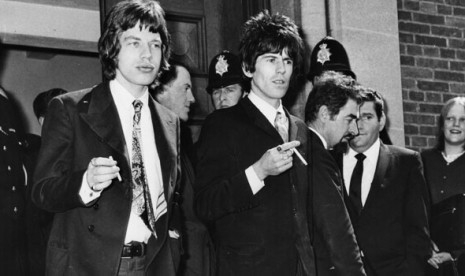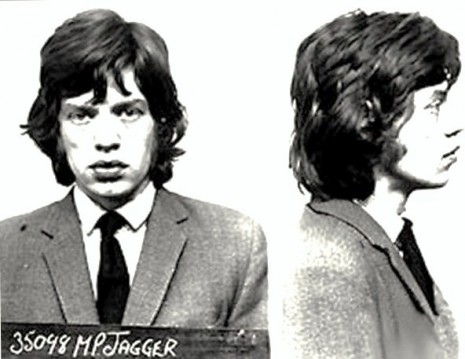
The recent News of the World ‘phone hacking scandal wasn’t the first time the red top used illicit means to obtain stories. Back in the swinging sixties, the paper regularly bartered with the police for information to use in its pages.
One of the News of the World’s tip-offs to the cops led to the most infamous drugs trial of the twentieth century, where Mick Jagger, Keith Richard of The Rolling Stones, and art dealer Robert Fraser were imprisoned in an apparent attempt to destroy the band’s corrupting influence over the nation’s youth.
For the first time, the true story behind the arrests and trial is revealed by Simon Wells in his excellent book Butterfly on a Wheel: The Great Rolling Stones Drugs Bust. Wells’ previous work includes books on The Beatles and The Stones, British Cinema and most recently, a powerful and disturbing biography of Charles Manson. In an exclusive interview with Dangerous Minds, Wells explained his interest in The Stones drugs bust:
‘As a student of the 1960s it was perhaps inevitable that I would collide with the whole Redlands’ issue at some point. Probably like anyone with a passing interest in the Stones, I first knew about it mainly from legend - the “Mars Bar”, the fur rug, the “Butterfly On A Wheel” quote etc. However, like most of the events connected to the 1960s, I was aware that there had to be a backstory, and not what had been passed down into myth. This story proved to be no exception, and hopefully, the facts are as sensational (if not more) than what has passed into mythology. Additionally, as a Sussex boy - I was familiar with the physical landscape of the story- so that was also attractive to me as well.’
Just after eight o’clock, on the evening of February 12 1967, the West Sussex police arrived at Keith Richards’ home, Redlands. Inside, Keith and his guests - including Mick Jagger, Marianne Faithfull, the gallery owner Robert Fraser, and “Acid King” David Schneiderman - shared in the quiet warmth of a day taking LSD. Relaxed, they listened to music, oblivious to the police gathering outside. The first intimation something was about to happen came when a face appeared, pressed against the window.
It must be a fan. Who else could it be? But Keith noticed it was a “little old lady.” Strange kind of fan. If we ignore her. She’ll go away.
Then it came, a loud, urgent banging on the front door. Robert Fraser quipped, “Don’t answer. It must be tradesmen. Gentlemen ring up first.” Marianne Faithfull whispered, “If we don’t make any noise if we’re all really quiet, they’ll go away.” But they didn’t.
When Richards opened the door, he was confronted by 18 police officers led by Police Chief Inspector Gordon Dinely, who presented Richards with a warrant to “search the premises and the persons in them, under the Dangerous Drugs Act 1965.”
This then was the start of the infamous trial of Mick Jagger, Keith Richards and Robert Fraser.
It may seem we all know a small piece of this story, but in fact as Butterfly on a Wheel: The Great Rolling Stones Drugs Bust shows, we’ve never seen the whole picture until now:
‘It was such a well-known story, I was amazed no one had written a book about it before. It’s one of the most incredible stories of the 20th-century and I couldn’t believe that it had been ignored - given that every other angle of the Stones in the 1960s had been thoroughly explored. Obviously, as I worked my way through the story I became aware of just how the mythology of the tale had been constructed over the years. For a decade awash with drugs, it was somewhat predictable that the events that night had been blown up to such a stratospheric level.’
Wells has written a 5 star book, which explains the full background story, bringing new information to the events surrounding the bust, with particular emphasis on the nefarious activities of the News of the World and a dodgy copper, Detective Sergeant Norman “Nobby” Pilcher.
‘I suppose it was predictable during the star-studded 1960s that London’s otherwise anonymous police force would create their own celebrity copper. In this case it was Detective Sergeant Norman Clement Pilcher,’ says Wells. ‘Norman or “Nobby” as he was known to his colleagues was quite a character, as was his insatiable desire to rise swiftly through the ranks of London’s police. Pilcher may well have had an agenda to curb the activities of London’s musicians, but my own take on him was that he knew the value a celebrity bust. While seemingly the majority of the capital’s youth were engaged in some form of narcotic use, Picher knew that busting a celebrity would raise his profile (and by association, his team) enormously.’

Richard Hamilton’s portrait of Mick Jagger and Robert Fraser under arrest.
Pilcher waged a war on pop’s elite. During his time at the Drugs Squad, Pilcher was responsible for arresting Donovan, Brian Jones, John Lennon and George Harrison. Pilcher always got his man, by bringing along to any bust his own supply of evidence. He was lampooned as a rock groupie by underground magazine Oz, and John Lennon described him as ‘semolina pilchard, climbing up the Eiffel Tower’ in “I Am The Walrus.”
In our present world of anodyne music pumped out by record labels and TV talent shows as a soundtrack for malls, lifts, and supermarkets, it is hard to believe that once-upon-a-time, music, in particular pop music, was considered revolutionary and a very real threat to the established order. Think of this when imagining the world The Rolling Stones burst into back in 1963, as it was the Stones, their music and their alleged drug use that became the focus of British establishment’s ire.
‘As far as attitudes towards soft drug use were concerned,’ Simon explains, ‘I would say it was the most important moment of the 20th century. A massive watershed of opinion that for the first time pitched elements of the so-called “Establishment” against the rebellious young - best exemplified in the metaphor of The Rolling Stones. Obviously, once battle lines were drawn it was going to get messy. With the benefit of hindsight, the debate was far too premature – it was only 22 years since the end of WW2 – and obviously many in authority had seen active service and were aghast at the sight of these youngsters strutting their stuff unhindered. Many saw it as an affront.’
Unlike The Beatles, who played the game, and were considered cheeky and harmless, wore suits and smiled, The Stones were deemed dirty, surly, long-haired, and played Black music - R ‘n’ B, that inflamed their fans to riot. All of this wasn’t helped by manager Andrew Loog-Oldham statement if The Beatles were Christ, then The Stones were the Anti-Christ.
Things started to go wrong, after one of The Stones’ riotous gigs, where the famous five had been whisked away from the venue as quickly as possible, but without a toilet break. On the way home, they pulled into a service station, where Bill Wyman asked to use the gents toilet. The garage attendant didn’t like the look of Wyman and his long hair, nor his gurning friends in the back of the van, and refused the bass player access. Jagger and Brian Jones became involved, with Jagger saying he could piss anywhere, which the 3 of them duly did. The incident led to a trial and a fine and was the first hint that someone had The Stones in their sights. If not the Establishment, then rogue elements:
‘I was at pains to point out what really the “Establishment” consisted of during the mid-1960s, and how “they” sought to enact their revenge against Mick, Keith, and Brian. Ultimately, I don’t believe it was men in suits in Westminster discussing the Rolling Stones and plotting their downfall. It’s a hugely romantic image, but it is frankly ludicrous. In reality, there was a Labour government in power who - believe it or not - was attempting to understand the new movement, and equally, were to rationalize drug use through a sweeping review of the arcane narcotic laws that had been in place since the war.
‘However, there were other – less regulated - elements of the so-called establishment that were outraged at the antics by the nation’s youth as exemplified by their defacto leaders- pop groups. Obviously, with The Beatles still the nation’s favorites, The Rolling Stones were an obvious target for sections of the “moral majority” to vent their spleen on. Predictably, it was the News Of The World who decided to infiltrate the Mick and Keith’s core circle and reveal their personal habits to their readership. The papers expose in turn gave the police carte blanch to raid members of the group. Soon, it was open season on musicians – but just not restricted to the UK, but elsewhere too. So the “Establishment” in a sense, yes, but not as many would like to believe.’
There was further rattling of teacups, when Richards purchased a 15th-century house, Redlands, in West Wittering, Sussex. The very thought that a working class guitar player could afford such a posh residence, curdled the milk on the breakfast tables of Middle England.
Add to this the shift in the news away from Wing Commanders and derring-do, to pop groups and hairstyles, saw a growing concern over the fall in the nation’s morals and its role models.
As The Beatles were unassailable, especially after Prime Minister Harold Wilson controversially honored them with MBEs in 1965, the press turned their eye to The Stones for any possible dirt.
Of particular interest was the rise in drug use amongst these young musicians. The News of the World set up a team of journalists to infiltrate The Stones’ circle and get the skinny on their drug use. One night, a journalist spoke with a drug-addled Brian Jones about his chemicals of choice. Thinking they had a major scoop, the paper ran the story. It was to prove a major mistake, as the News of the World couldn’t tell their pop stars apart, and believed they had caught Mick Jagger unawares, rather than Jones. When the paper published its story on Jagger and his alleged drug confession, the singer sued the paper. It led the tabloid to plan its revenge to discredit Jagger.

More on Simon Wells ‘The Great Rolling Stones Drugs Bust’, after the jump…





